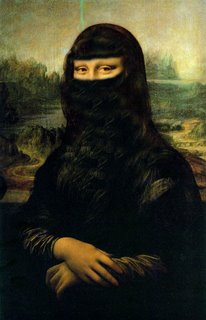There is a need for a coherent and consistent approach to the “Ban the Burka” Debate. Can we reject UK Islamist Abu Rumaysah ordering his female interviewer to “Cover Up. Wear the Hijab!” and at the same time seek to limit how a Muslim woman may dress in public, even going to the length of imposing legal restrictions on her clothing? Yes we can, and here’s why.
I yesterday launched an article (“Tell me What to Wear, and I’ll Tell you Where to Go”) showing UK Islamist Abu Rumaysah telling Clarissa Ward, his CBS interviewer to “Cover up. Wear the hijab.” In that article I explored the limits of freedom of personal dress and argued that Rumayash’s order and the debate to ‘Ban the Burka’ in certain public settings are NOT morally equivalent.
Our first principle should be to protect the Freedom of personal dress, however this freedom is not limitless and must be balanced against freedom of speech, public safety, and protecting vulnerable individuals and communities.
While we may decide as a community to adopt certain minimal standards and norms for dress, most of us would be loathe to involve the Law in these social negotiations, which rightly fall into the non-legal realm of etiquette. That said, I will now outline three conditions under which it is legitimate to comment upon, critique and even involve the law in the personal dress of adults.
First, when clothing becomes a political statement it is entering the role of the social – and may be critiqued as any other socio-political action.
Let me give you a non-Islamic example: I recall a family of Messianic Jews that used to live in the Jewish enclave suburb in which I worked. The girls each wore small head-covering scarfs. That in of itself is a case of personal dress and no-one’s business but their own. However, the scarves had a large border on them which read, “Jesus is Lord.” – At THAT point they have entered the sphere of the social and could rightly expect a passerby to comment (positively or negatively).
Those around them should be able to support/critique that action just as if the girls were carrying placards. The same holds true, even if the political message is not a written statement but a symbol – Consider a university-age Social Alternative student who shows up to a Liberal Party Fundraiser wearing a red T-Shirt with the communist hammer and sickle on it.
Even closer to our current discussion, it may even be that the item of clothing itself becomes the political message. Imagine a young man with a sharp crew-cut that walks around in a clearly recognisable brown NAZI uniform. Even without a swastika on his arm, this is no longer personal dress – it is a political statement and may be critiqued as such. He cannot turn around to me and say, “What, it’s just a choice of personal dress,” No it’s not, you’re making a public political statement, and I’m free to comment on it. In the same way, a Muslim woman cannot argue that her Hijab, niqab or Burka is merely a choice of clothing, as it is, in our current context, a symbol of a larger network of socio-political ideas, that are rightly part of public discussion.
I might still be hesitant to involve the Law in these cases, but I certainly would want to endorse the freedom of individuals to comment upon these clothing choices.
Second, the public is allowed to be interested in its own safety and the Government ought to intervene when there is a reasonable threat to that safety in public spaces.
Much has been made of the specifics regarding what forms of clothing – in particular face-coverings, may reasonably be worn in public spaces. On one side are those who sincerely hold that there is a security risk when individuals are allowed to bypass standard security checks (such as being able to be recognised on CCTV cameras). On the other side are those who are sincerely concerned that using the law to place limits on freedom of dress may impede upon or discriminate against many who pose no threat whatsoever. Some are even concerned that legislation may be being used to maliciously target particular groups of people due to ethnic or religious prejudice.
Now I want to say clearly that being watchful for unnecessary encroachments of government power into people’s personal lives is at base a good thing – We should be continually vigilant in this area, and to some extent my own ‘spidey-sense’ has kicked-in with some of the proposed changes. However, governments are negligent when they fail to balance limiting government intervention and power against the protection and safety of their citizens.
The challenge here is that what is “reasonable” is not fixed, but contingent upon the events of the day. “Reasonable” restrictions on freedom of dress, will increase or decrease depending on the level of threat and risk to the community. Sadly (and even if it is a hard or unpalatable decision to make), with the increased threats coming from the Muslim community at this time, it may well be legitimate to increase the restrictions upon dress in public areas. One caveat here, is that most of the aggressors so far have been Muslim Men and it is not immediately clear how restricting the dress of Muslim Women will protect the public’s safety.


Third, and perhaps most important of all, communities and governments (in certain cases even the governments of other countries) may legitimately intervene in matters of dress, when the item of dress is NOT freely chosen, and is being used as a tool to maliciously control citizens.
Think here of current day Iran, where all women must, by law, be completely identically covered, or of a situation such as Mali in 2012-2013 before the French reinforcements, when women were being harassed in the streets if they weren’t sufficiently covering their bodies and faces. A classic non-Muslim example could be the Jewish ‘Yellow Star of David.’ (N.B. Yes, I know about Godwin’s Law – but the argument still holds!)
This then becomes not an issue of personal dress, where we should in principle just butt out and let people wear what they want, but rather an item of dress is being used as a tool to segregate, subjugate and oppress.
Many Muslim women are in this situation now and need our help. And just like a Jew who has accepted NAZI propaganda and believes it is good for him to wear ‘the star’ – we would still be right in helping targeted groups be free from these restrictions, even if there are individuals within that group who believe they prefer wearing it.
In Conclusion, Yes freedom of dress deserves to be protected, but no freedom exists to the exclusion of other contextual factors. The “Ban the Burka” debate holds moral legitimacy where Abu Rumaysah’s order, “Cover Up. Wear the Hibjab” does not, because (1) Muslim dress is not purely personal expression, but political action, (2) recent events have highlighted that certain public restrictions are warranted, and (3) The covering of women’s faces and bodies is not purely personal preference but is a tool of a larger program of control and subjugation of women, for whom we must be willing to advocate.
Photo by Ken Bingham 










